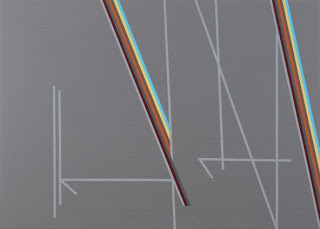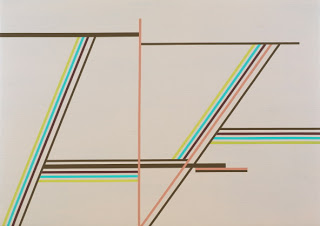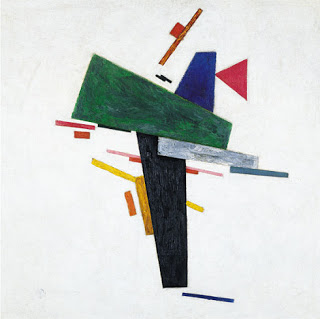Art Vent Letting the Fresh Air In
September 20, 2011
Those who ignore history are doomed to repeat it -- earlier post), a monumental, voluminous construction made of transparent PVC that hung from ceiling to floor and took the shape of an elliptical labyrinth—which Ribé first made 42 years ago when the MoMA artist, a Brazilian named Carlito Carvalhosa, was eight years old.
But wait…the MoMA piece has a “sound” aspect: “a system of microphones hangs from various heights and records the day’s ambient noise, which is played back the following day through several speakers” something that might seem interesting when described in wall text or a press release, but in real life makes zero impact. The first time I experienced anything like that was at Chicago’s N.A.M.E. Gallery circa 1973 when a local artist recorded the sound occurring in one part of the gallery and played it back in another. I didn’t know about Bruce Nauman at the time, but I’m guessing he was beginning to work with sound then too—when Carvalhosa would have been twelve.
The global art world is flooded with hothouse conceptual art much like this, which Jerry Saltz recently coined the “International School of Silly Art.” Born in institutions, and exhibited in institutions, mechanical and denatured, it has the look but not the guts of its predecessors. Neither building on a tradition nor reacting to one, it exists in a vacuum—a rehashing of history without being part of it.
On the other hand, as I’ve pointed out before, the music of the same generation is alive and well and living in this century. Young musicians have absorbed the music of the 60s, 70s, and 80s, synthesized it and made it their own. Also to make music you can’t just say you’re a musician but must learn an actual skill, and I fervently believe that the honing of a skill—a practice (a word Peter Schjeldahl hates when applied to visual art, but I like because it implies necessary repetition)—slows down the creative process and allows the time and space for idiosyncrasy to emerge.
This is why Marina Abramović’s The Artist is Present was completely effective, where the recreations of the older pieces that accompanied it were not. Everything Abramović did the past, all her experience—her “practice”—added up to a personal presence that filled the room, something a stand-in who lacked the artist’s peculiar self-training could never approximate, especially when the thrill and risk of doing it for the first time was gone. (It’s curious that Abramović, whose work involves self-awareness, didn’t get this distinction).
But, hmm, maybe the über-liberals of the art world are just following a societal trend that includes the Republicans, who rewrite history every day without batting an eye. If we can do something lame and make everyone believe it’s new, important and exciting, why work harder?
I’m not arguing for new or old, but the development of ideas and forms—any idea, any form—that takes art beyond the mundane, is something I think about the next day and am eager to revisit. Saltz again, in a 2008 interview, challenged artists to make something that seems “to put off more energy than might have gone into making it. A good Pollock,” he continued, “is like the burning bush: It burns but doesn’t burn out. You don’t use it up.”
Up until October 8th at Meulensteen in Chelsea (formerly Max Protetch) are the small acrylic paintings on metal of Ann Pibal who, while just five years Carvalhosa’s senior, has clearly thoroughly studied and digested the history of a nearly century-old form—geometric abstraction—to create work that's fresh and of its time—which is just what we want: art that doesn’t replicate history, but makes it.
Satisfaction is rare, but it does happen.
Ann Pibal, MNGO, 2010, acrylic on aluminum, 12 1/2 x 17 3/4", courtesy of the artist and Meulensteen, NY.
Ann Pibal, SPTR, 2010, acrylic on aluminum, 11 1/4 x 15 3/4", courtesy of the artist and Meulensteen, NY.
Comments (5)
September 7, 2011
The rain seems to have washed away all my brain cells, as well as any interest in art whatsoever, resulting in an inadvertent hiatus from my blog. I absolutely refuse to write drivel just to keep things going. However, given that the rat race art season begins this week--openings galore!--inspiration will surely come my way. Meanwhile French office workers need neither galleries or an art season, but have generated a lively competition with art made from Post-It Notes. More here from the Guardian:
August 23, 2011
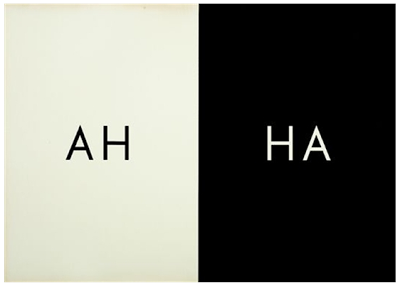 |
| Bruce Nauman, 1975, serigraph (copyright may apply). |
My new friend Nina (who I met in Barcelona thanks to Facebook), writes to ask if I’ve read Sherry Turkle's Alone Together: Why We Expect More from Technology and Less from Each Other
The big thinkers Gabler cites as having been “crowded out by informational effluvium”—psychologist Steven Pinker and biologist Richard Dawkins—are hardly obscure, and he forgets the popularity in recent years of “idea” books by authors like Malcolm Gladwell and Alain de Botton
and Alain de Botton .
.
The problem is actually more cultural than technological—Americans have always been suspicious of intelligence—and I’m here to tell you that ideas are alive and well and living in Europe (which also has the Internet and Facebook, BTW), specifically England and Spain from which I've recently returned. While I’m guessing that 999 out of a 1000 Americans (and I could be being generous here) can’t identify Jasper Johns, arguably our most famous living artist, in England every cabbie can name the winner of this year’s Turner Prize. Used as I am to the American media’s constant ridiculing of art and artists, I was blown away by the coverage of the exhibition I went to see in Spain of Àngels Ribé, a conceptual artist. Every day there was a major article in another publication, each more intelligent and respectful than the last, and while I don’t understand Catalan, the lengthy television news presentation I saw was so beautifully shot it could have been a documentary.
Just to prove my point, I offer this quote from de Tocqueville (found on Facebook in a discussion of this article):
The practice of Americans leads their minds to other habits, to fixing the standard of their judgment in themselves alone. As they perceive that they succeed in resolving without assistance all the little difficulties which their practical life presents, they readily conclude that everything in the world may be explained, and that nothing in it transcends the limits of the understanding. Thus they fall to denying what they cannot comprehend; which leaves them but little faith for whatever is extraordinary and an almost insurmountable distaste for whatever is supernatural.
---Alexis de Tocqueville, Democracy in America , 1835
, 1835
If Gabler thinks we don’t care about ideas anymore, maybe he just needs smarter Facebook friends.
August 22, 2011
After I read, along with poetry, portions of my blog at the Berkshire Museum Thursday evening, I thought these would be fun to repost, as they never appeared consecutively:
WEDNESDAY, SEPTEMBER 26, 2007
Bad studio day
This latest painting is just bad, a mishmash. I was on such a roll, now sent to the depths. I think it’s because I started it before the last one was finished. There was just picky stuff to do, with lots of drying time in-between, so I thought, start another one, why not? Except that for me, good paintings come from wanting to see something realized so badly that I’ll do whatever it takes. To start one too soon is like starting a new love affair before the old one is finished.
Richard, who I went to see to console myself, said—without having seen it—that the problem with this painting is that it’s green. He’s right. How often do you see a good green painting?
THURSDAY, SEPTEMBER 27, 2007
Better studio day
I got up this morning and the painting didn’t look so bad, although it was still green.
A friend, a personal trainer by profession, wanted to know what it meant to have a “bad studio day” and I found it hard to explain, which got me wondering if there’s any other field where you can so often feel as if you’ve never done this thing before. I asked Scott, who's both an artist and chef, if he’s ever experienced it in the kitchen, and he said, “No.” Do trial lawyers ever suddenly feel as if they’ve never been in a courtroom? I doubt it. Roberto describes it as one of those moments when he begins to wonder, “How did I get this job, anyway?”
So there you are and you know nothing. And even though other artists are aware of how profoundly depressing it is, they’ll gleefully tell you—and you’ll tell everyone else as long as you’re not going through it—that it’s an exciting place to be and means your art isn’t stagnant, but growing and developing. Thanks a bunch.
So Richard came over and declared the painting “a good beginning” and pointed out where it “needs work”—i.e. most of it—although, of course, he couldn’t be specific as to what that work would look like. He described painting as “an accumulation of accidents,” and suggested that whether they turn out to be happy ones or not is sometimes just a matter of luck. I still think it's all about degree of interest, of how invested I am in seeing the final image, but now that it's become a challenge, I'm getting more interested.
FRIDAY, SEPTEMBER 28, 2007
Not so bad studio day
The painting is slowly, painfully, improving, but it’s still GREEN—even though I’ve spent all day adding lots of other colors to it. That’s because green swallows every color that touches it. Painters, take a look at your once-white bristle brushes. Have you ever noticed that they’re all GREEN? If they aren’t, it’s only because you were smart enough never to use green in the first place.
SUNDAY, SEPTEMBER 30, 2007
Ridiculous studio day
I couldn’t stand the green, so I stained everything alizarin yellow . Now there’s a color you really can’t get rid of. I must be out of my mind. And what am I doing with a giant tube of alizarin yellow anyway? Did I buy this thing? It’s like having a bomb in the bottom of my paint drawer.
SUNDAY, OCTOBER 7, 2007
Grey studio day
I don’t know if it’s a talent, like perfect pitch, or an acquired skill, but I can easily mix any color I need—except grey, which is the color I’ve wanted this painting to be all along. "That’s because," Ann said this afternoon, "there’s no such thing as grey; there’s only green, blue or violet." Now she tells me! Is this one of those things, like Santa Claus and snipe hunts, that everyone else found out about in second grade, and no one clued me in on? Obviously all those labels on paint are just a joke, and when someone comes into, say, Pearl Paint and actually purchases a tube of Holbein Grey of Grey, the salespeople are cracking up behind the cash registers. Well I’m nothing if not determined, so I looked up “mixing grey oil” on Google, and up came a bunch of sites that are obviously perpetuating the myth. But I fooled them! I took all of the colors mentioned on all of the sites and mixed them together and got...GREEN.
TUESDAY, OCTOBER 9, 2007
Tough love studio day
Have I been whining a lot? I guess so, because today Roberto came over and said he didn’t think my painting was as bad as he'd expected. He said the color was good, that the alizarin yellow turned out to be great as underpainting—but that I’m painting what I want to see rather than what’s really there. His exact words were, “It’s naïve, but not in a good way.” Only a true friend would say that. Of course, I knew he was right; I was just hoping that I could fool him the way I was trying to fool myself into thinking this painting was Gerhard Richter-esque when it’s really more like Maurice Sendak, minus the Wild Things.
I’d hoped for a happy ending—I was committed to the idea that a painting blog should be inspirational—but instead I’m going to take Roberto’s advice, retire this thing for a while and start another. And this time I’ll try not to be so histrionic about it.
Meanwhile there’s Jeanette and Erica’s wedding and an article to write for Art in America on Marisol. The great thing about having two vocations is that it makes for very productive procrastination: I do some of my best painting when I’m supposed to be writing and, conversely, having a deadline gives me a great excuse not to paint.
WEDNESDAY, NOVEMBER 29, 2007
WEDNESDAY, NOVEMBER 29, 2007
Satisfied studio day
I've been working on my GREEN painting for an hour or so this morning--after months, it's almost finished--and I love it so much I can't stop looking at it. I was about to write, "Isn't life weird?" until I remembered my old boy friend, Claude, saying, "Compared with what?"
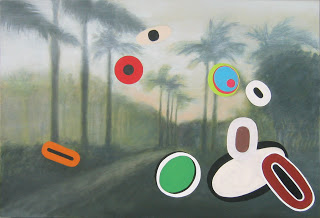 |
| Carol Diehl, Isla de Encanta II, 2007, oil on panel, 17" x 25" |
August 21, 2011
August 14, 2011
Often, as a guest artist, I meet people from far-flung parts of the country who want to know how they can have an art career if they live in, say, Akron (apologies to Akron, if it has a vibrant scene I don’t know about). They often look startled at the suggestion that they could perhaps move, when, in any other profession, normal procedure would be to go where the opportunities are. It’s possible for some people, I suppose, to make great art in a vacuum, but most of the time when artists aren’t actively part of the bigger conversation, the work lags.
There is, however, another option: make your own scene.
Artist-run galleries, publications, coops that convert industrial buildings for studio space, or even pop-up exhibitions, are just some of the ways artists can band together and take charge of their own environment. This summer, in out-of-the-way places—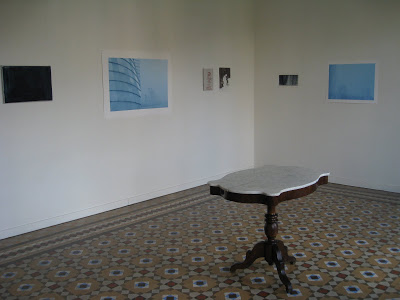
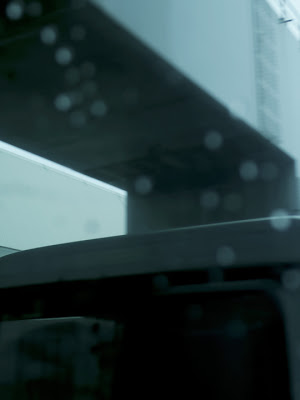 |
| Nina Zurier, Sleepwalking, 2011, inkjet print, 34" x 18". |
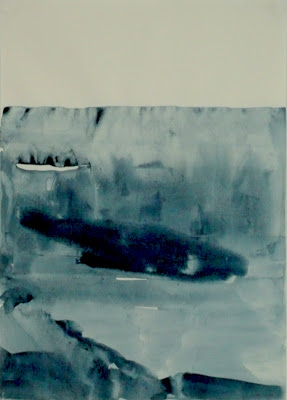 |
| John Zurier, Iceland (loft), 2011, ink on paper, 11.6" x 8.2". |
| Jack in his studio. |
And then I just couldn't resist taking a photo of what has to be the most beautiful bathroom in the world, which echoes the blue theme:
August 3, 2011
July 24, 2011
Another trip nicely enhanced by Facebook! When friends from Norway learned that I was going to be in London when they were, we arranged to meet at the Peter Zumthor pavilion at the Serpentine Gallery. Each year the Serpentine commissions a temporary work by a well-known architect. The last one I saw was by Frank Gehry, whose work I do admire, but that project looked like something he’d handed over to an intern (the pictures here make it look much more interesting than it actually was). Black, monolithic, and forbidding on the exterior, the Zumthor pavilion contains a nice surprise in the form of a rectangular atrium, open to the sky, with a central flower garden running its length, as well as tables and chairs for sitting and enjoying a spot of tea. It seems appropriate and much more generous for an architect to build something with a function—especially one that encourages lingering and socializing—rather than an oversize sculpture you can only walk around in and supposedly be awed by.
